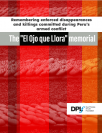Following the end of armed conflict or a repressive regime, an essential part of the transitional justice process is knowing and remembering the truth about the human rights violations committed. All victims and survivors are entitled to the truth, and to recognition and memory of the abuses carried out against them.
Memory initiatives such as memorials and commemorative practices help to create a historical record as well as a public recognition of what happened to the victims. At the same time, these kinds of practices and events, which are so crucial for fulfilling victims’ rights and promoting healing, often become spaces of contention and even generate violent responses against them. This has been the case with the Eye that Cries (El Ojo que Llora) in Lima, Peru, a memorial to the victims of Peru’s twenty-year internal armed conflict (1980-2000).
This publication, authored by Peruvian transitional justice expert and DPLF consultant Eduardo González, explores the relevance of the Eye that Cries memorial today. The analysis comes at a moment of prolonged political crisis and extreme uncertainty in Peru —a moment that has echoes of the past, including authoritarian tendencies, State-led and State-justified violence, and human rights abuses being committed with an ever-present threat that they will remain unpunished. In addition to reflecting on the significance of the Eye that Cries memorial for victims and families of victims, in examining the different narratives and tensions around the space this exploration implores us to consider the unfinished work and failure to fulfill the pillars of transitional justice following the end of Peru’s internal armed conflict.
Click here to read the full analysis.






